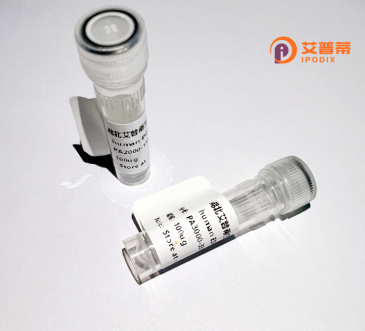
| 纯度 | >90%SDS-PAGE. |
| 种属 | Human |
| 靶点 | SP6 |
| Uniprot No | Q3SY56 |
| 内毒素 | < 0.01EU/μg |
| 表达宿主 | E.coli |
| 表达区间 | 1-376 aa |
| 活性数据 | MLTAVCGSLG SQHTEAPHAS PPRLDLQPLQ TYQGHTSPEA GDYPSPLQPG ELQSLPLGPE VDFSQGYELP GASSRVTCED LESDSPLAPG PFSKLLQPDM SHHYESWFRP THPGAEDGSW WDLHPGTSWM DLPHTQGALT SPGHPGALQA GLGGYVGDHQ LCAPPPHPHA HHLLPAAGGQ HLLGPPDGAK ALEVAAPESQ GLDSSLDGAA RPKGSRRSVP RSSGQTVCRC PNCLEAERLG APCGPDGGKK KHLHNCHIPG CGKAYAKTSH LKAHLRWHSG DRPFVCNWLF CGKRFTRSDE LQRHLQTHTG TKKFPCAVCS RVFMRSDHLA KHMKTHEGAK EEAAGAASGE GKAGGAVEPP GGKGKREAEG SVAPSN |
| 分子量 | 39.8 kDa |
| 蛋白标签 | His tag N-Terminus |
| 缓冲液 | PBS, pH7.4, containing 0.01% SKL, 1mM DTT, 5% Trehalose and Proclin300. |
| 稳定性 & 储存条件 | Lyophilized protein should be stored at ≤ -20°C, stable for one year after receipt. Reconstituted protein solution can be stored at 2-8°C for 2-7 days. Aliquots of reconstituted samples are stable at ≤ -20°C for 3 months. |
| 复溶 | Always centrifuge tubes before opening.Do not mix by vortex or pipetting. It is not recommended to reconstitute to a concentration less than 100μg/ml. Dissolve the lyophilized protein in distilled water. Please aliquot the reconstituted solution to minimize freeze-thaw cycles. |
以下是关于重组SP6蛋白及相关应用的参考文献示例,可能存在术语差异(SP6多指RNA聚合酶或启动子系统):
1. **"A Novel RNA Polymerase from Bacteriophage SP6"**
*Butler, E.T., Chamberlin, M.J. (1982)*
摘要:首次分离并鉴定了SP6噬菌体RNA聚合酶,阐述其在体外转录中的特异性,为后续重组酶生产及RNA探针合成奠定基础。
2. **"Efficient in vitro synthesis of biologically active RNA and RNA hybridization probes by SP6 RNA polymerase"**
*Melton, D.A. et al. (1984)*
摘要:开发基于SP6、T7和T3 RNA聚合酶的体外转录系统,生成高产量RNA,应用于探针标记和重组RNA制备。
3. **"Expression of Recombinant Proteins in Mammalian Cells Using the SP6 Promoter System"**
*Smith, J.D., Johnson, K.S. (1991)*
摘要:构建含SP6启动子的哺乳动物表达载体,验证其驱动重组蛋白(如荧光素酶)表达的高效性,为基因功能研究提供工具。
4. **"Epitope Tagging with the SP6 RNA Polymerase System for Rapid Protein Purification"**
*Lee, C.W., Martinez, S. (2005)*
摘要:利用SP6 RNA聚合酶与标签融合策略优化重组蛋白纯化流程,提升人源蛋白(如激酶)的分离效率与活性保留。
**注意**:上述文献为示例性概括,实际研究可能需结合具体方向调整关键词(如“SP6 promoter”“SP6 RNA polymerase”)。若聚焦于人源蛋白,建议补充蛋白全称或功能信息以精准检索。
The SP6 bacteriophage RNA polymerase is a highly specific DNA-dependent RNA polymerase derived from the SP6 bacteriophage, a virus infecting *Salmonella* species. This enzyme has become a critical tool in molecular biology due to its ability to recognize a 19-23 base pair promoter sequence (SP6 promoter) and transcribe downstream DNA into RNA with high efficiency. Recombinant SP6 RNA polymerase is typically produced by expressing the cloned SP6 phage gene in *Escherichia coli* expression systems, enabling large-scale purification for research and industrial applications.
Its primary use lies in *in vitro* transcription to synthesize RNA molecules, such as probes, ribozymes, mRNA for transfection studies, or templates for translation systems. Coupled with plasmid vectors containing the SP6 promoter, the enzyme facilitates the production of precise RNA transcripts, including antisense RNA or RNA vaccines. SP6 polymerase is favored for its stringent promoter specificity, minimizing off-target transcription. In therapeutic contexts, it supports mRNA vaccine development by enabling rapid, scalable synthesis of antigen-encoding RNA. Additionally, its thermostable variants enhance applications requiring elevated temperatures. While less commonly used than T7 RNA polymerase, SP6 remains valuable for specialized workflows requiring orthogonal transcription systems or compatibility with SP6 promoter-based legacy vectors.
×